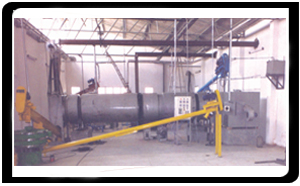
SAKAV DRYERS handle all types of materials. Recognising that virtually every drying application is unique. Each Rotary Cascade Dryer is purposely designed to meet specific matenal characteristics by analysing the client's process requirement. the correct design solution is assessed & selected by.
Minerals· Metal Ores - Fertilisers· Foodstuff - Chemicals -Industrial & Domestic waste.
OPERATING TEMPERATURE :- 60°C to 1OOO°C.
CAPACITY :- 5 TPD TO 150 TPD
SIZE & MOISTURE :- Capable of Handling different product particle size & moisturecontent.
Drying / cooling is achieved by passing the material to be processed through a rotating cylinder through which also passes a current of tempered air. Lifters/flights or louvres in the case of rotary louvre dryer, are fitted to the Internal surface of the cylinder to give intimate contact between product and drying or cooling air stream. In Rotary Louvre dryers the material IS not lifted and dropped through the drying air stream, therefore less product breakdown occurs. Rotary Louvre dryers can also be arranged for multi-stage drying, or drying and cooling in one Unit.
Co-current Flow Rotary Cascade Dryers, sticky and heat sensitive materials, since the wet material IS exposed to the highest temperature gases, the initial heat transfer rate is very high, rapidly evaporating surface moisture. The Immediate and dramatic fall in gas temperature prevents a sudden Increase in the matenal and shell temperatures. The final product is in contact with the lower temperature gases enabling the moisture content to be readily controlled thereby avoidrnq over-drying. Counter-Current Flow drying in a Rotary Cascade Dryer gives lower product moisture than co-current flow for a given inlet temperature. However, its use with heatsensitive rnatenals IS limited since the dryed product comes into contact with the heating medium at its highest temperature. It is suitable for application where an extremely low moisture content is required or where a higher product temperature is anadvantage.
Gas. Diesel, oil, electric, stream. The drying gas are provided from either a direct fired furnace or an indirect heat exchanger within the range 100 to 1000 C using solid, gaseous or liquid fuel. Only products of combustion or indirectly heated gases enter the Rotary Cascade Dryer. This prevents surface contamination while reducing the risk of damage or fire when handeling more sensitive materials. A two fan balanced draught system IS used to provide the maximum degree of control & flexibility. In arrangements and the drying gases are provided by a locally mounted burner projecting the flame down the centre of the dryer through which the material cascades. This design gives even greater thermal efficiency due to the higher temperature differential, the direct flame contact and the radiation effect, when processing materials which can withstand high gas temperatures without deterioration.
Carbon, Stainless or custom alloy steel plate, with external reinforcing bands for fitting of tyres and drive rings. Flights and lifters or louvres are welded or bolted internally. Confifuration is determined by application.
Drum is rotated by an electric motor through V-belts, gearbox, pinion and either heavy duty chain to a chainwheel or spur gear drive ring bolted around the dryer drum. For high temperature operation, tangent plates are utilized to allow for differential expansion.
Ends of drum may be enclosed by carbon or alloy steel fabricated end plates or hood With Inlet/outlet chutes and suitable seals
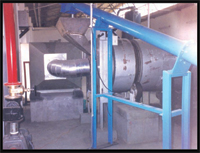
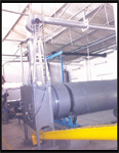
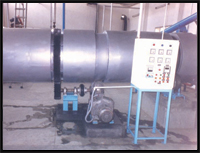
| No. | Name |
|---|---|
| 1 | Burner |
| 2 | Hot air generator |
| 3 | Front duct |
| 4 | Rotary dryer body |
| 5 | Lifting flight |
| 6 | Rear duct |
| 7 | Drive |

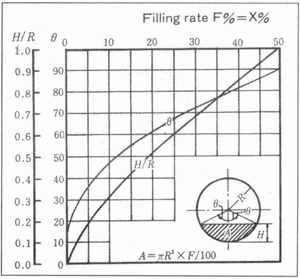
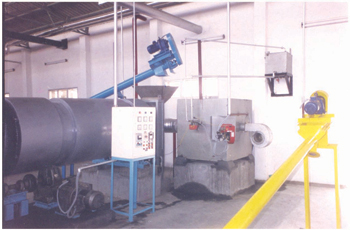
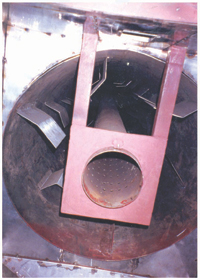
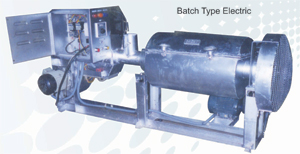

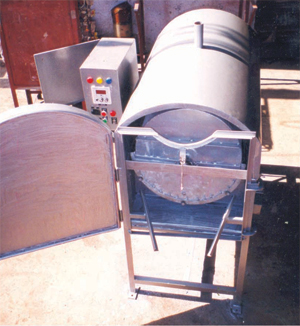
Dimensions and the other data of the Rotary Dryers depend on the material properties, water content. dryness, drying capacity, etc. The values of motor horsepower given in the table are those required to rotate the rotary dryer alone. The figures do not Include the horsepower requirements to operate the exhaust, burner material feeder etc.